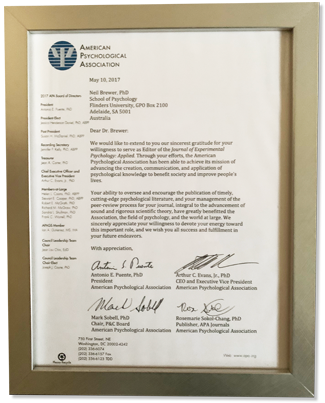Semmler, C., & Brewer, N. (2023). The assessment of eyewitness memory for people and events. In D. Lorandos (Ed.), The Litigator’s Handbook of Forensic Medicine, Psychiatry and Psychology (Vol.2, pp.1-89). Thomson West.
Lucas, C. A., & Brewer, N. (2022). Could precise and replicable manipulations of suspect-filler similarity optimize eyewitness identification performance? Psychology, Public Policy and Law, 28, 108-122.
Brewer, N., & Doyle, J. (2021). Changing the face of police lineups: Delivering more information from witnesses. Journal of Applied Research in Memory and Cognition, 10, 180-195.
Brewer, N., Zweck, T., Lucas, C. A., & Guidolin, M. (2022). Eyewitnesses’ pre-lineup memory strength inferences can influence identification decisions. Journal of Police and Criminal Psychology, 37, 339-350.
Lucas, C. A., Brewer, N., & Palmer, M. A. (2021). Eyewitness identification: The complex issue of suspect-filler similarity. Psychology, Public Policy, and Law, 27, 151-169.
Palmer, M. A., Brewer, N., Weber, N., & Sauer, J. D. (2021). Eyewitness identifications of multiple culprits: Disconfirming feedback following one lineup decision impairs identification of another culprit. Psychology, Public Policy, and Law, 27, 170-183.
Douglass, A. B., Lucas, C. A., & Brewer, N. (2021). Co-witness identification speed affects false identification rates. Law and Human Behavior, 44, 474-484.
Lucas, C. A, Brewer, N., Michael, Z., & Foster, T. (2020). The effects of explicit ‘not present’ and ‘don’t know’ response options on identification decisions in computer administered lineups. Applied Cognitive Psychology, 34, 1495-1509.
Kucina, T., Sauer, J. D., Holt, G. A., Brewer, N., & Palmer, M. A. (2020). Refining the blank lineup procedure: How should we instruct eyewitnesses? Applied Cognitive Psychology, 34, 1419-1429.
Wells, G. L., Kovera, M. B., Douglass, A. B., Brewer, N., Meissner, C., & Wixted, J. (2020). Policy and procedure recommendations for the collection and preservation of eyewitness identification evidence. Law and Human Behavior, 44, 3-36.
Brewer, N., Weber, N., & Guerin, N. (2020). Police line-ups of the future? American Psychologist, 75, 76-91.
Brewer, N., Lucas, C. L., Sauer, J. D., & Palmer, M. A. (in press, 2020). Measuring the relationship between eyewitness identification confidence and accuracy. In A. Smith, M. Toglia, & J. Lampinen (Eds.), Methods, measures, and theories in eyewitness identification tasks. New York, NY: Taylor & Francis.
Sauer, J. D., & Brewer, N. (in press, 2020). Ratings-based identification procedures. In A. Smith, M. Toglia, & J. Lampinen, Methods, measures, and theories in eyewitness identification tasks. New York, NY: Taylor & Francis.
Powell, M. B., Garry, M., & Brewer, N. (2019). Eyewitness testimony. In I. Freckelton & H. Selby (Eds.), Expert evidence: Law, practice, procedure and advocacy (5th ed.), 65-1-5072 . Pyrmont, NSW: Thomson Reuters.
Sauer, J. D., Palmer, M. A., & Brewer, N. (2019). Pitfalls in using eyewitness confidence to diagnose the accuracy of an individual identification decision. Psychology, Public Policy and Law, 25, 147-165.
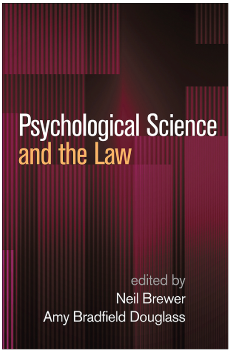
Brewer, N., & Douglass, A. B. (2019) (Eds.). Psychological science and the law. New York: Guilford.
Douglass, A. B., & Brewer, N. (2019). Psychology and the criminal justice system. In N. Brewer & A. B. Douglass (Eds.), Psychological science and the law. New York: Guilford.
Sauer, J. D., Palmer, M. A., & Brewer, N. (2019). Eyewitness identification. In N. Brewer & A. B. Douglass (Eds.), Psychological science and the law. New York: Guilford.
McCallum, N., & Brewer, N. (2018). Can lineup administrators blind to the suspect’s identity influence witnesses’ decisions? Psychiatry, Psychology and Law, 25, 93-105.
Horry, R., & Brewer, N. (2016). How target-lure similarity shapes confidence judgments in multiple-alternative decision tasks. Journal of Experimental Psychology: General, 145, 1615-1634.
Horry, R., Brewer, N., & Weber, N. (2016). The grain-size lineup: A test of a novel eyewitness identification procedure. Law and Human Behavior, 40, 147-158.
Horry, R., Brewer, N., Weber, N., & Palmer, M. A. (2015). The effects of allowing a second sequential lineup lap on choosing and probative value. Psychology, Public Policy and Law, 21, 121-133.
Horry, R., Cheong, W., & Brewer, N. (2015). The other race effect in perception and recognition: Insights from the complete composite task. Journal of Experimental Psychology: Human Perception and Performance. 41, 508-524.
Sauer, J. D., & Brewer, N. (2015). Confidence and accuracy of eyewitness identification. In T. Valentine & J. Davis (Eds.), Forensic facial identification: Theory and practice of identification from eyewitnesses, composites and CCTV (pp. 185-208). London, UK: Wiley-Blackwell).
Lucas, C. A., & Brewer, N. (2015). Eyewitness identification when “The Perpetrator Reminds me of Someone I Know”. Psychiatry, Psychology and Law, 22, 49-59.
Horry, R., Halford, P., Brewer, N., Milne, R., & Bull, R. (2014). Archival analyses of eyewitness identification test outcomes: What can they tell us about eyewitness memory? Law and Human Behavior, 38, 94-108.
Palmer, M. A., Brewer, N., Weber, N., & Nagesh, A. (2013). The confidence-accuracy relationship for eyewitness identification decisions: Effects of exposure duration, retention interval, and divided attention. Journal of Experimental Psychology: Applied, 19, 55-71.
Palmer, M. A., Brewer, N., & Horry, R. (2013). Understanding gender bias in face recognition: Effects of divided attention at encoding. Acta Psychologica, 142, 362-369
Horry, R., Palmer, M. A., & Brewer, N. (2012). Backloading in the sequential lineup prevents within-lineup criterion shifts that undermine eyewitness identification performance. Journal of Experimental Psychology: Applied, 18, 346-360.
Brewer, N., Weber, N., Wootton, D., & Lindsay, D. S. (2012). Identifying the bad guy in a lineup using deadlined confidence judgments. Psychological Science, 23, 1208-1214.
Horry, R., Palmer, M. A., Brewer, N., & Cutler, B. L. (2012). Comparative legal psychology. In D. S. Clark (Ed.), Comparative law and society (pp. 133-153). Cheltenham, UK: Edward Elgar Publishing.
Sauer, J. D., Brewer, N., & Weber, N. (2012). Using confidence ratings to identify a target among foils. Journal of Applied Research in Memory and Cognition, 1, 80-88.
Sauer, J. D., Weber, N., & Brewer, N. (2012). Using ecphoric confidence ratings to discriminate seen from unseen faces: The effects of retention interval and distinctiveness. Psychonomic Bulletin and Review, 19, 490-498.
Palmer, M. A., Brewer, N., & Weber, N. (2012). The information gained from witnesses’ responses to an initial “blank” lineup. Law and Human Behavior, 36, 439-447.
Palmer, M. A., & Brewer, N. (2012). Sequential lineup presentation promotes less biased criterion setting but does not improve discriminability. Law and Human Behavior, 36, 247-255.
Palmer, M. A., Horry, R., & Brewer, N. (2011). Court relevant research methods. In K. Sheldon, J. Davies, & K. Howells (Eds.), Research in practice for forensic professionals (pp. 86-107). New York, NY: Routledge.
Semmler, C., Brewer, N., & Douglass, A. B. (2011). Jurors believe eyewitnesses. In B. L. Cutler (Ed.), Conviction of the innocent: Lessons from psychological research (pp. 185-209). Washington, DC: APA Books.
Brewer, N., & Wells, G. L. (2011). Eyewitness identification. Current Directions in Psychological Science, 20, 24-27.
Brewer, N. (2011 The Police Journal (Opinion section): Practical advantages in computerized photo line-ups. (April 2011 Volume 92 No 2)
Brewer, N. (2011). The Conversation: Pictures perfect: Why photo lineups can be better at catching crooks. http://theconversation.edu.au/articles/pictures-perfect-why-photo-lineups-can-be-better-at-catching-crooks-2257
Palmer, M. A., Brewer, N., & Weber, N. (2010). Postidentification feedback affects subsequent eyewitness identification performance. Journal of Experimental Psychology: Applied, 16, 387-398.
Sauer, J., Brewer, N., Zweck, T., & Weber, N. (2010). The effect of retention interval on the confidence-accuracy relationship for eyewitness identification. Law and Human Behavior, 34, 337-347.
Brewer, N., Keast, A., & Sauer, J. D. (2010). Children’s eyewitness identification performance: Effects of a Not Sure response option and accuracy motivation. Legal and Criminological Psychology, 15, 261-277.
Douglass, A. B., Brewer, N., & Semmler, C. (2010). Moderators of post-identification feedback effects on eyewitnesses’ memory reports. Legal and Criminological Psychology, 15, 279-292.
Palmer, M. A., Brewer, N., McKinnon, A. C., & Weber, N. (2010). Phenomenological reports diagnose accuracy of eyewitness identification decisions. Acta Psychologica, 133, 137-145.
Brewer, N., & Palmer, M. (2010). Eyewitness identification tests. Legal and Criminological Psychology, 15, 77-96.
Brewer, N., & Wells, G. L. (2009). Obtaining and interpreting eyewitness identification test evidence: The influence of police-citizen interactions. In R. Bull, T. Valentine, & T. Williamson, (Eds.), Handbook of psychology of investigative interviewing: Current developments and future directions (pp. 205-220). Chichester, UK: John Wiley.
Mansour, J., Lindsay, R. C. L., Brewer, N, & Munhall, K. (2009). Characterizing visual behavior in a lineup task. Applied Cognitive Psychology, 23, 1012-1026.
Lindsay, R. C. L., Semmler, C., Weber, N., Brewer, N., & Lindsay, M. R. (2008). How variations in distance affect eyewitness reports and identification accuracy. Law and Human Behavior, 32, 526-535.
Sauer, J. D., Brewer, N., & Weber, N. (2008). Multiple confidence estimates as indices of eyewitness memory. Journal of Experimental Psychology: General, 137, 528-547
Brewer, N., Weber, N., Clark, A., & Wells, G. L. (2008). Distinguishing accurate from inaccurate eyewitness identifications with an optional deadline procedure. Psychology, Crime and Law, 14, 397-414.
Brewer, N., & Weber, N. (2008). Eyewitness confidence and latency: Indices of memory processes not just markers of accuracy. Applied Cognitive Psychology, 22, 827-840.
Weber, N., Brewer, N., & Margitich, S. (2008). The confidence-accuracy relation in eyewitness identification: Effects of verbal versus numeric confidence scales. In K. H. Kiefer (Ed.), Applied psychology research trends (pp. 103-118). Hauppauge, NY: Nova Science Publishers.
Jones, E. E., Williams, K. D., & Brewer, N. (2008). “I had a confidence epiphany!” Obstacles to combating post-identification confidence inflation. Law and Human Behavior, 32, 164-176.
Sauer, J. D., Brewer, N., & Wells, G. L. (2008). Is there a magical time boundary for diagnosing eyewitness identification accuracy in sequential lineups? Legal and Criminological Psychology, 13, 123-135.
Brewer, N. (2008). Confidence in identifications. In B. L. Cutler (Ed.), Encyclopedia of psychology and law (pp.138-142). Thousand Oaks, CA: Sage Publications.
Semmler, C., & Brewer, N. (2008). Pop-out effect in eyewitness identification. In B. L. Cutler (Ed.), Encyclopedia of psychology and law (pp. 600-601). Thousand Oaks, CA: Sage Publications.
Weber, N., & Brewer, N. (2008). Response latency and eyewitness identification. In B. L. Cutler (Ed.), Encyclopedia of psychology and law (pp. 692-693). Thousand Oaks, CA: Sage Publications.
Keast, A., Brewer, N., & Wells, G. L. (2007). Children’s metacognitive judgments in an eyewitness identification task. Journal of Experimental Child Psychology, 97, 286-314.
Brewer, N., Weber, N., & Semmler, C. (2007). A role for theory in eyewitness identification research. In R. C. L. Lindsay, D. F. Ross, J. D. Read, & M. Toglia (Eds.), Handbook of eyewitness psychology: Volume 2: Memory for people (pp. 201-218). Mahwah, NJ: Lawrence Erlbaum.
Semmler, C., & Brewer, N. (2006). Postidentification feedback effects on face recognition confidence: Evidence for metacognitive influences. Applied Cognitive Psychology, 20, 895-916.
Brewer, N., Caon, A., Todd, C., & Weber, N. (2006). Eyewitness identification accuracy and response latency. Law and Human Behavior, 30, 31-50.
Brewer, N., & Wells, G. L. (2006). The confidence-accuracy relationship in eyewitness identification: Effects of lineup instructions, foil similarity and target-absent base rates. Journal of Experimental Psychology: Applied, 12, 11-30
Brewer, N. (2006). Uses and abuses of eyewitness identification confidence. Legal and Criminological Psychology, 11, 3-24.
Weber, N., & Brewer, N. (2006). Positive versus negative face recognition decisions: Confidence, accuracy, and response latency. Applied Cognitive Psychology, 20, 17-31.
Brewer, N., & Day, K. (2005). The confidence-accuracy and decision latency-accuracy relationships in children’s eyewitness identification. Psychiatry, Psychology and Law, 12, 119-128.
Brewer, N., Weber, N., & Semmler, C. (2005). Eyewitness identification. In N. Brewer & K. D. Williams (Eds.), Psychology and law: An empirical perspective (pp. 177-221). New York: Guilford.
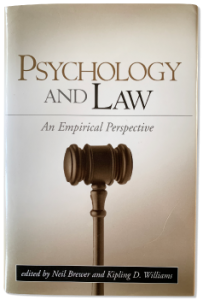 Brewer, N., & Williams, K. D. (Eds.) (2005). Psychology and law: An empirical perspective. New York: Guilford.
Brewer, N., & Williams, K. D. (Eds.) (2005). Psychology and law: An empirical perspective. New York: Guilford.
Brewer, N., Williams, K. D., & Semmler, C. (2005). Psychology and law research: An overview. In N. Brewer & K. D. Williams (Eds.), Psychology and law: An empirical perspective (pp. 1-10). New York: Guilford.
Semmler, C., Brewer, N., & Wells, G. L. (2004). Effects of postidentification feedback on eyewitness identification and nonidentification confidence. Journal of Applied Psychology, 89, 334-346.
Weber, N., & Brewer, N. (2004). Confidence-accuracy calibration in absolute and relative face recognition judgments. Journal of Experimental Psychology: Applied, 10, 156-172.
Weber, N., Brewer, N., & Wells, G. L. (2004). Is there a “magical” decision latency that discriminates correct from incorrect eyewitness identifications? In A. Czerederecka, T. Jaśkiewicz-Obydzińska, R. Roesch, & J. Wójcikiewicz (Eds.), Forensic psychology and law (pp. 115-124). Kraków, Pl: Institute of Forensic Research Publishers.
Weber, N., Brewer, N., Wells, G. L., Semmler, C., & Keast, A. (2004). Eyewitness identification accuracy and response latency: The unruly 10-12 second rule. Journal of Experimental Psychology: Applied, 10, 139-147.
Weber, N., & Brewer, N. (2003). The effect of judgment type and confidence scale on confidence-accuracy calibration in face recognition. Journal of Applied Psychology, 88, 490-499.
Weber, N., & Brewer, N. (2003). Confidence-accuracy calibration for absolute and relative judgements. In M. Vanderhallen, G. Vervaeke, P. J. Van Koppen, & J. Goethals (Eds.), Much ado about crime: Chapters on psychology and law (pp.151-160). Brussel, Belgium: Uitgeverij Politeia N.V.
Brewer, N., Keast, A., & Rishworth, A. (2002). The confidence-accuracy relationship in eyewitness identification: The effects of reflection and disconfirmation on correlation and calibration. Journal of Experimental Psychology: Applied, 8, 46-58.
Brewer, N., Gordon, M., & Bond, N. (2000). Effect of photoarray exposure duration on eyewitness identification accuracy and processing strategy. Psychology, Crime, and Law, 6, 21-32.

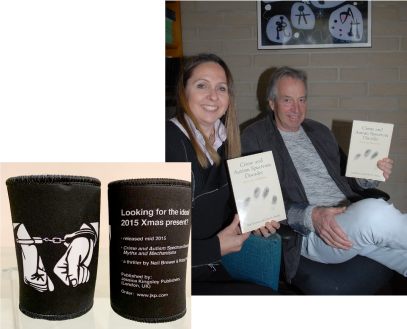

 Brewer, N., & Williams, K. D. (Eds.) (2005). Psychology and law: An empirical perspective. New York: Guilford.
Brewer, N., & Williams, K. D. (Eds.) (2005). Psychology and law: An empirical perspective. New York: Guilford.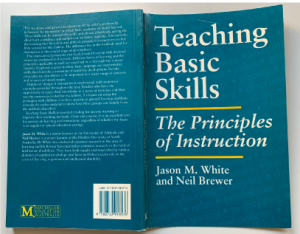
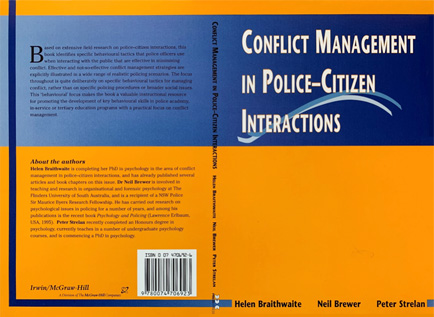

 Brewer, N. (1995). Supervision and leadership. In N. Brewer & C. Wilson (Eds.), Psychology and policing (pp. 291-316). Hillsdale, NJ: Lawrence Erlbaum.
Brewer, N. (1995). Supervision and leadership. In N. Brewer & C. Wilson (Eds.), Psychology and policing (pp. 291-316). Hillsdale, NJ: Lawrence Erlbaum.